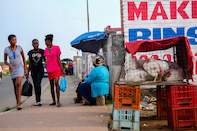
Drivers
The driver should not only like animals, but also be familiar and know how to address animal welfare issues that may arise during transportation. The safety and welfare of the birds should be considered throughout the trip and the vehicle should be handled in a manner that prevent the slipping or falling of containers.Stops and Lengths of Journeys
All paperwork should be completed prior to catching and loading, so the vehicle may leave the premises immediately after loading. Journeys should not exceed twenty-four hours and stops should only be made when absolutely necessary. When stopping in hot weather, the vehicle should be able to maintain ventilation and temperatures in the load space.Fasting
Birds should not be deprived of feed or water before transportation and, during the transportation phase, may not be without food or water for more than twenty-four hours measured from the time of last feeding or drinking.Climatic Conditions
Steps should be taken to protect birds against adverse weather conditions, especially over long distances. During hot weather birds should be loaded and transported during the cooler parts of the day, either early morning, late afternoon or at night.Handling of Birds
Adult birds should be caught individually and be handled by both legs and the body fully supported. No more than three layers or breeders and no more than four broilers may be carried per hand per person at a time.
should be moved smoothly, not be tilted more than 20 degrees during any stage of loading or unloading and never be thrown or dropped. Tie down devices should be used to prevent containers from overturning.
The containers, crates, baskets or purpose made wire mesh cages in trolleys used during transportation should be clean and designed for the handling and transportation of the birds.
The way in which these containers are stacked should not obstruct air movement in and out of the containers. Birds should not be able to stick their heads, wings or legs out of the containers.
Birds
Only healthy and vigorous chicks should be transported. Climatic conditions, the duration of the journey and design of a container should be considered when determining the stocking density of birds.
In general, each live chick should have access to at least 20 cm². For layers, the stocking density should be less than 55 kg body mass per square meter, while it should be less than 70 kg per square meter when broilers are transported.
Live Birds
Record needs to be kept of sales, which includes the contact details of buyers as well as the number of birds sold and their health status. For biosecurity reasons, buyers should not be allowed in the production facilities and live bird sales should take place from a dedicated sales area outside of the biosecure zone.Declaration
Declaration Confirmation as per the certification in the Code of Practice should be given as to:- Whether the birds were free of visible signs of disease and that no abnormal mortalities have been reported in the flock in the preceding thirty days.
- That the birds have been tested for notifiable Salmonellae and complies with the requirements in the Salmonellae Movement Protocols.
- The birds have been tested for notifiable avian influenza according to the HPNAI Contingency Plan and complies with the requirements in the document.
- The birds have been tested for Newcastle Disease according to the “Movement Control Protocol in case of Newcastle disease” and complies with the requirements in the protocol.
- The birds have been handled in accordance with the current SAPA Code of Practice for Live Bird Sales.